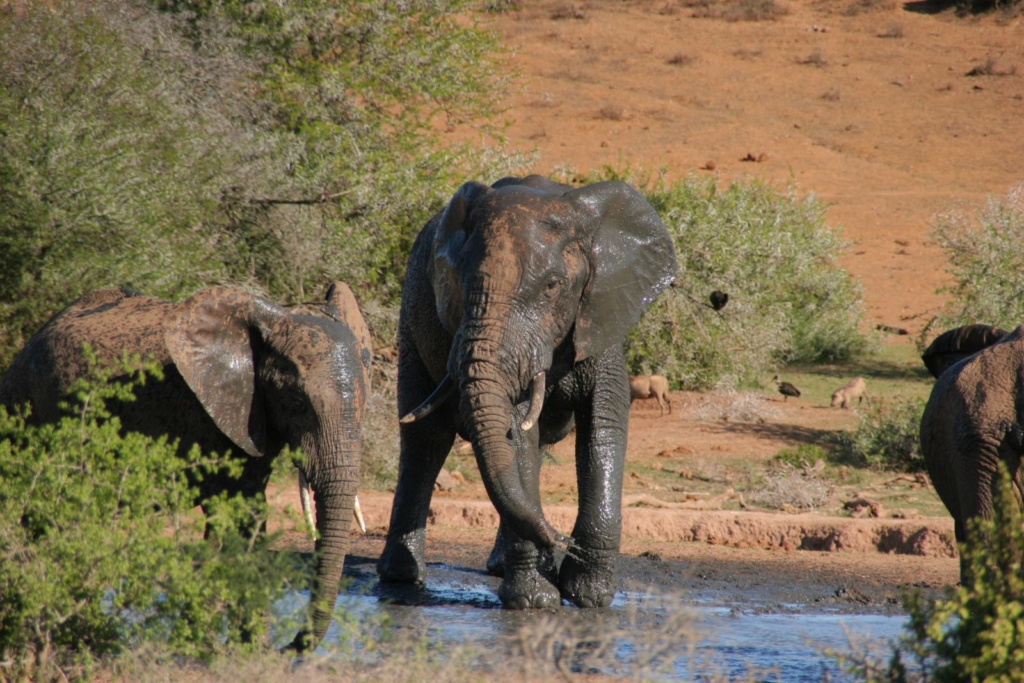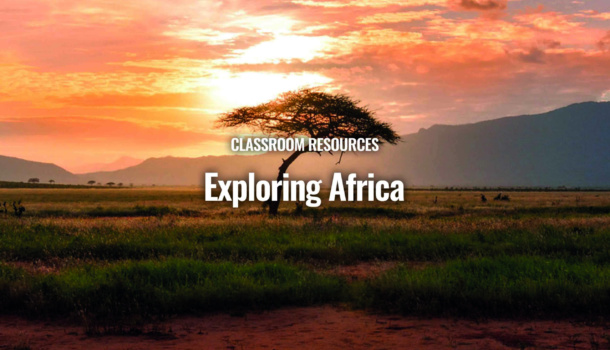Exploring Africa
What can we learn from Africa’s kaleidoscope of cultures, climates and creatures? Find out in this series of cross-curricular lesson plans and activities for Key Stages 2 and 3.
£25+ VAT
Purchase this teaching resource
- up to 300 users
- up to 300 users
- up to 300 users
Africa is a the most diverse continent on the planet. Comprising 55 countries and countless cultures, it is home to over one billion people and more than a thousand languages. Some say it is home to all people, as it is believed the first humans originated from Africa.

This massive continent – the second largest of them all after Asia – is also home to a rich variety of wildlife with populations of large carnivores, herbivores, reptiles, primates, aquatic life, and over a quarter of the world’s bird species. Megafauna like giraffe, zebra, gorilla, hippopotamus, chimpanzee and wildebeest are unique to Africa.
One important reason for this abundant assortment of plant and animal life is the diversity of climates on mainland Africa and the islands off its coast. It’s the only continent to stretch from the northern temperate zone to the southern temperate zone, with climates ranging from tropical areas with jungles and rainforests to wide open savannah and dry deserts and grasslands – there are even sub-arctic areas on the mountain peaks.
Africa is rich with natural resources, but for many reasons, including historical colonialism, bad leadership, disease and exploitation, the continent still struggles with abject poverty and underdevelopment. Its wildlife is in danger too. Many animals living there have been pushed to the brink of extinction due to human activity – from the poaching of the black rhinoceros for its valuable horn (worth more than its weight in gold), to the collection of Madagascan chameleons for the exotic pet trade, to the poisoning of big cats by farmers and herders to protect their land and flocks. And both animals and humans are suffering the effects of aggressive deforestation. Woodland is destroyed in Africa at twice the world rate.
The study of Africa thus provides a wealth of valuable learning opportunities. The majority of this project focuses on the geographical, social and scientific value of exploring the cultures, climates and creatures of Africa. However, there are plenty of opportunities to develop students’ research and literacy skills throughout, beginning with the reciprocal reading of a traditional West African tale. There is particular emphasis on the conservation of nature and the protection of endangered species.
.png)
This cross curricular project plan includes:
‘The Blind Man and the Hunter’ text
A traditional West African tale about a hunter who learns the value of wisdom and kindness. Available as a pdf and a separate word document (formatted to make mass printing easier and more cost effective). Both can be found below in Activity 1: Reading the text.
Image bank
Images of African animals and landscapes to accompany the activities in this project plan.
Activity 1: Reading the text
The purpose of this activity is to encourage active thinking and reading through close examination of the West African tale ’The Blind Man and the Hunter’, using the reciprocal reading roles of summariser, predictor, clarifier and questioner. Includes instructions and:
- Activity sheet 1a – Reading roles record sheet
- Activity sheet 1b – RECALL strategy sheet (an alternative collection sheet to Activity sheet 1a)
- Activity sheet 1c – Group roles cards (to cut out and assign to each student)
- Activity sheet 1d – WOW worksheet (Working Out Words)
- ‘The Blind Man and the Hunter’ text (pdf and word doc)
Activity 2: Africa as a continent
Students investigate Africa’s position on the globe and produce a large-scale map of the continent showing its countries and major geographical features. Includes instructions and:
- Activity sheet 2a – Africa mindmap template
- Activity sheet 2b – Student introduction
- Activity sheet 2c – Africa’s countries (map)
- Activity sheet 2d – Africa’s climate (map)
- Activity sheet 2e – Research log template
- Activity sheet 2f – Map of Africa’s bodies of water
- Activity sheet 2g – Map of Africa’s major rivers
- Activity sheet 2h – Africa fact file
Activity 3: Africa’s countries
Pupils plan, create and present a PowerPoint to the class on one of Africa’s countries, focusing predominantly on geographical features and information.
Includes instructions and:
- Activity sheet 3a – Student introduction and research prompts
- Activity sheet 3b – The regions of Africa (map)
- Activity sheet 3c – African countries: Key information
- Activity sheet 3d – Comparing rainfall and temperature
Activity 4: Life in Africa
Students create a culturegram (an image bank) about the lives of people in Africa.
Includes instructions and:
- Activity sheet 4a – Student introduction A (one country in Africa)
- Activity sheet 4b – Student introduction B (one aspect of African life)
- Activity sheet 4c – Example culturegram
Activity 5: Comparing climates
Students compare average temperature and rainfall in the Sahara Desert and the Congo Rainforest, considering the diversity of African climates and the implications for the way of life in that country. Includes instructions and:
- Activity sheet 5a – Temperature and rainfall in the Sahara Desert
- Activity sheet 5b – Temperature and rainfall in the Congo Rainforest
- Activity sheet 5c – Comparing temperature and rainfall
Activity 6: Africa’s animals
Students design an information booklet about an African animal. Includes instructions and:
- Activity sheet 6 – Student introduction
Activity 7a: Protecting Africa’s endangered animals
Students identify and research endangered animals. They then create a poster informing people how the animal has become endangered and how it can best be protected. Includes instructions and:
- Activity sheet 7a – Student introduction
- Activity sheet 7b – Top ten most endangered animals in Africa
Activity 7b: Writing a news story
Students write a news piece on one issue related to the conservation of animals in Africa. Includes instructions and:
- Activity sheet 7c – Student introduction
Activity sheet 7d – Example news story
Activity sheet 7e – What makes an effective news story?
Activity 8: Gashaka-Gumti National Park
Students carry out a role-play to gain a better understanding of conservation and the threats facing the animals, land and people involved. The activity culminates in the students creating a news item for the children’s show, Newsround. Includes instructions and:
- Activity sheet 8a – What is a national park? (starter)
- Activity sheet 8b – Card sort cut outs (starter)
- Activity sheet 8c – Newsround report
- Activity sheet 8d – Role-play cards
- Activity sheet 8e – Interview sheet
- Activity sheet 8f – Gashaka-Gumti National Park maps
Activity 9: Virtual safari
Students use presentation or video-editing software to create a dramatised virtual safari around an African game reserve of their choice Includes instructions and:
- Activity sheet 9a – Student introduction
- Activity sheet 9b – What should your safari include? (prompt sheet)
- Activity sheet 9c – 12 of Africa’s National Parks
Activity 10: Creature creations
Students design a plant or animal that is adapted to life in a chosen African climate – desert, savannah, rainforest or steppe. Includes instructions and:
- Activity sheet 10 – Student introduction
.jpg)
Activity 11: Explorers of Africa
Students research an explorer of Africa and write a diary entry for a significant event in their voyages. Includes instructions and:
- Activity sheet 11a – Student introduction
- Activity sheet 11b – Explorers of Africa: Brief bios
- Activity sheet 11c – David Livingstone
- Activity sheet 11d – Mary Kingsley
- Activity sheet 11e – Writing an in-role diary entry
- Activity sheet 11f – Research grid
- Activity sheet 11g– Research log
Further reading
Global Perspectives Examined: Roger Sutcliffe describes a new international GCSE to stimulate critical thinking and research about global issues.
Perceptions Of Place: Martin Renton explains how Martin Renton explains how thinking critically about thinking critically about images can improve pupils’ understanding of the world they live in and help break down stereotypes.
